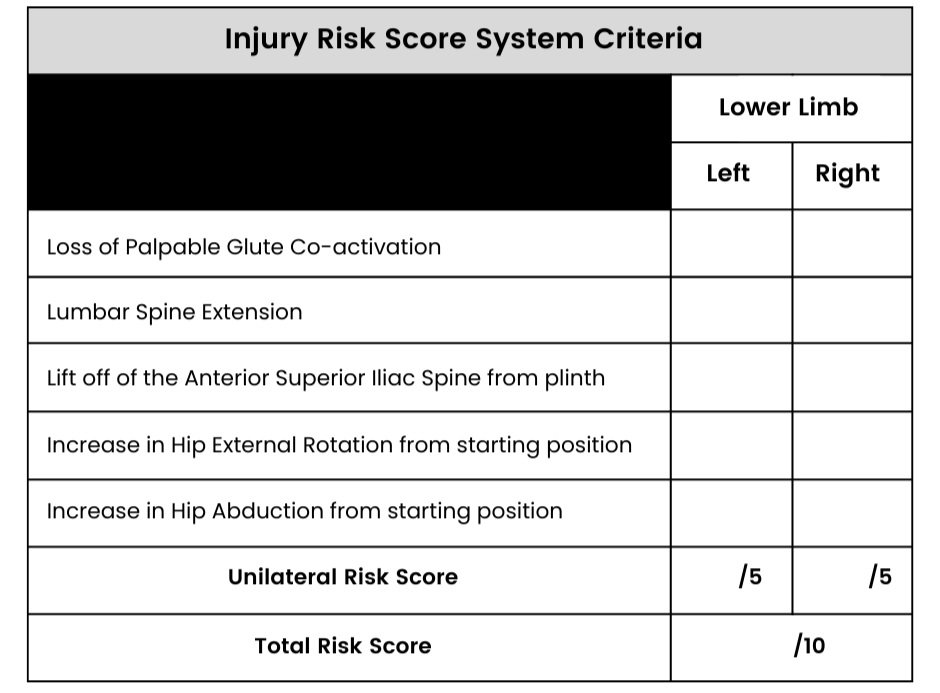The Prone Hip Extension and Knee Flexion Test
Reading time: 5 minutes
Accessing hip function provides a window into your patient's athletic future. Many injuries can happen due to poor eccentric control of the hip. ChiroUp has already outlined how to evaluate and treat this dysfunction. However, today's blog examines the concentric function of the hip. Hip extension fuels explosive athletic activity, including running and jumping.
Today’s blog will provide one reliable hip test to access hip function. Patients failing this test have a 35% increase in posterior chain injuries (PCIs). If you are looking to add one new evaluation to help your patients avoid low back pain, hamstring strains, and calf injuries, you will want to read this blog to its completion and watch the video!
Performing the Prone Hip Extension and Knee Flexion Test
Position your patient prone on a table. Instruct the patient to tense both buttock muscles and maintain this contraction for the test duration. Then slowly bend their knee to 90 degrees. Finally, lift the same knee off the table. Once completed on one side, repeat on the opposite side. The practitioner is looking for five criteria to assess joint compensatory movements demonstrating loss of hip stability. You will access and score these five factors.
Loss of glute coactivation: Hip extension occurs from glute activation. Other muscles and joints must compensate if there is a lack of glute activation.
Lumbar spine extension: If there is a lack of hip extension, the lumbar spine must excessively extend for proper athletic function.
Lift off of the anterior superior iliac spine from the bench: Excessive activation of the lumbar spine erectors and ipsilateral quadratus lumborum results in hip rotation placing the lumbar spine at a disadvantage.
Increase in external hip rotation from the starting position: Patients recognizing the lack of glute activation must recruit accessory muscles of hip extension, including the external rotators.
Increase in hip abduction from the starting position: Typical compensation for weak gluteal muscles is over-activation of the TFL, resulting in hip abduction. These are your patients with chronic lateral hip pain and tenderness within the TFL, sometimes extending down to the lateral knee by the IT band.
Score the Prone Hip Extension and Knee Flexion Test with the Injury Risk Score (IRS)
Observe the compensatory movement patterns for each of the five criteria. You will score 1 point per compensation. There is a maximum of 5 points per side and a maximum of 10 points achievable for the entire test. The higher the score alerts the provider to the severity of hip dysfunction.
The Injury Risk Score (IRS) from the Prone Hip Extension and Knee Flexion Test helps you identify possible risk factors for your athletes. Most posterior chain injuries result from inefficient biomechanics within the musculoskeletal system. The hip is a window into lower extremity dysfunctions. Modifiable risk factors to avoid these injuries include deficits in strength, overload in training, and reduced range of motion. These are all risk factors you can address in your office. Now you have the proper evaluation to notice the deficit. The Prone Hip Extension and Knee Flexion Test is simple and easy to use in your office. If positive, these patients have a 35% increase in posterior chain injury incidence. (1)
What are the TWO most common treatments for hip dysfunction?
The most common deficit demonstrated by your patients will be (1) lack of hip extension and (2) lack of gluteus activation. Fortunately, ChiroUp subscribers can access quick exercises and treatments to address these common deficits.
1. Increase hip extension with the Hip Extension with Overpressure mobilization.
Begin in a half-kneeling position with the knee of the affected side on the floor, bent at 90 degrees of flexion. Move the foot of the unaffected side forward 12-18 inches until you feel a stretch in the front of your involved hip. Finally, place your hands behind your hips and lean forward to stretch your hip further. When you feel like you can't go any further, push your hips forward with your hands, and exhale. Hold this position for 1-2 seconds, then relax your pressure. Repeat adding pressure and releasing pressure in a rhythmical pattern of 1-2 seconds on and 1-2 seconds off. Stop if the movement causes increased pain or your hip range of motion decreases after five repetitions. Repeat as directed.
2. Strengthen Gluteal Muscles
Improving glute activation is tricky as many of your patients may suffer from the other four compensations listed above. So, how do you strengthen the glutes without exploiting the other compensations the patient may already be exhibiting? Strengthening the glutes without over-activating the Tensor Fascia Latae (TFL) is vita Research has examined how to accomplish this goal and it starts with the clam exercise. (2)
Lie on your side with your feet together; knees bent at 90 degrees and hips at 45 degrees. Place an elastic band around the outside of both knees. Lift your knee upward without rolling your hips back. Maintain a pain-free range of motion. Slowly lower your legs so that your knees are touching. Perform as directed.
Posterior chain injuries are almost expected within the athletic population, resulting in a loss in playing time and sometimes are season-ending. Screening elite athletes for susceptibility to these types of injuries is up to us. Evidence-based chiropractors are best suited to address biomechanical deficits, thereby keeping athletes on the field.
Did you know ChiroUp can automate the way you prescribe exercises like the ones above? Get started with your 14-day FREE trial today to check it out!
-
Hughes R, Cross M, Stokes K, Tobin D, Power E, McNally S, Pamment J. Novel biomechanical injury risk score demonstrates correlation with lower limb posterior chain injury in 50 elite-level rugby union athletes. BMJ open sport & exercise medicine. 2021 Oct 1;7(4):e001062. Link
Fetto J, Leali A, Moroz A Evolution of the Koch model of the biomechanics of the hip: clinical perspective. J Orthop Sci. 2002; 7(6):724-30.



